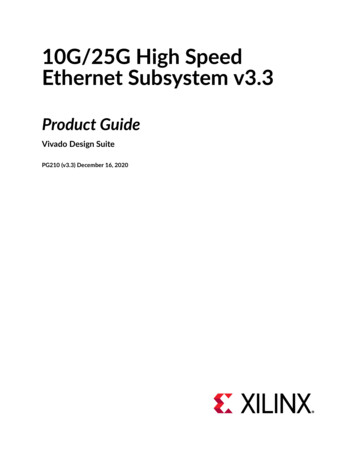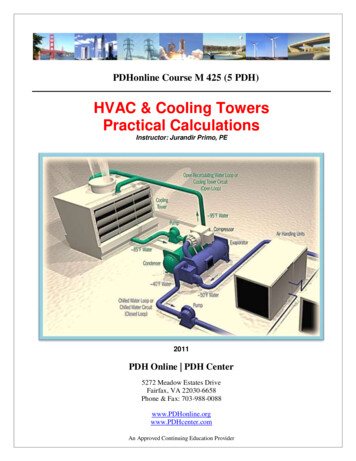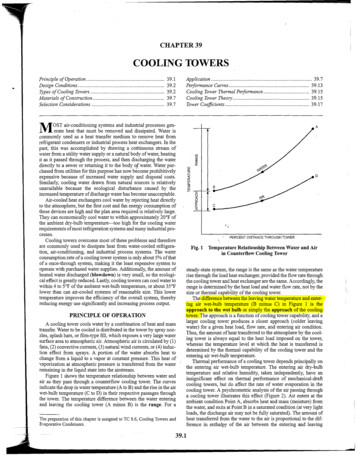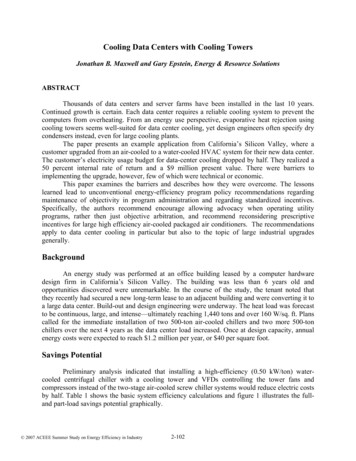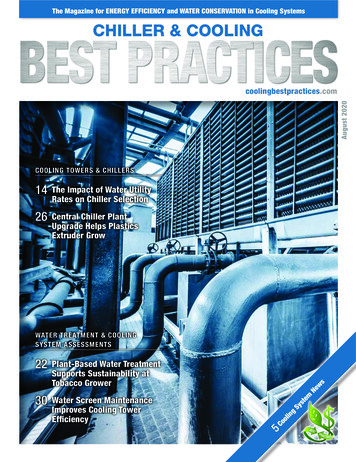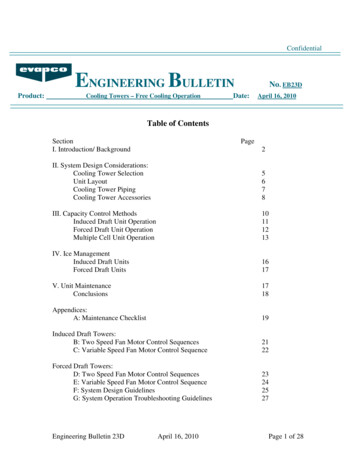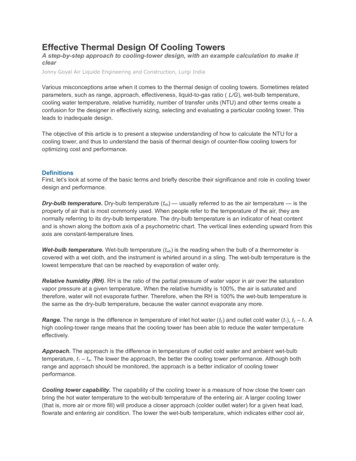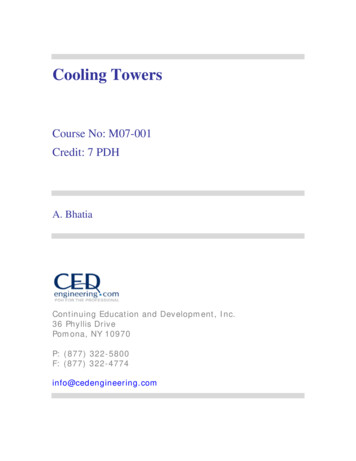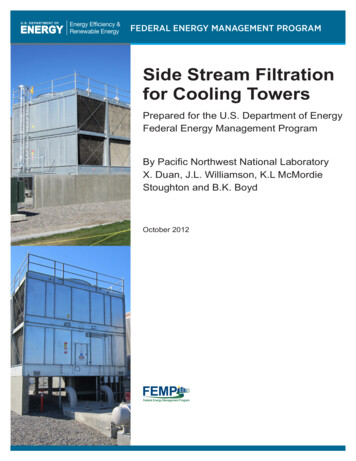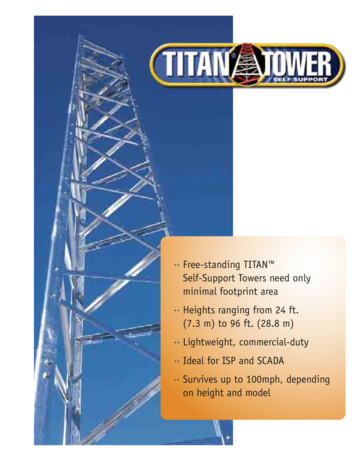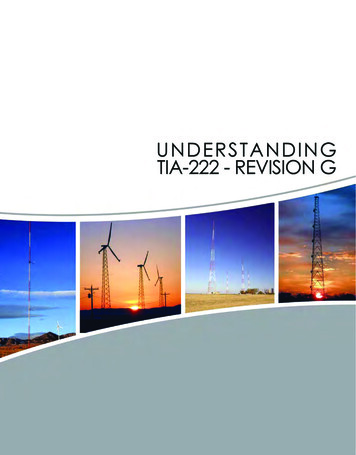
Transcription
IROHN SOLUTIONSU N D E R S TA N D I N G T I A - 2 2 2 - R E V I S I O N GWhat is Rev G?Rev G is the latest revision of the TIA-222 Standard “Structural Standards for Antenna Supporting Structures and Antennas”.The previous version of the Standard was Rev F. Rev G is based on a 3-second gust wind speed and Rev F is based on a fastestmile wind speed. The wind speeds are not directly comparable and it is very important to define the basis of a wind speedwhen specifying wind loading requirements. For a given location, the 3-second gust wind speed represents the peak gustwind speed whereas the fastest-mile wind speed represents the average wind speed over the time required for one mile ofwind to pass the site.Rev G presents additional factors to be considered in the design of new structures and for the modification of existingstructures. These factors are briefly discussed below. The reliability requirements of a structure can now be accounted for byassigning a classification to a structure (Class I, II or III). The wind speed can also be adjusted based on the type of terrainsurrounding the site (Exposure B, C or D) and if the site is located on a hill, ridge or escarpment (Topographic Category 1-5).Many tower profiles in this catalog now include antenna loading capacities for both Exposure B and Exposure C terrainconditions located on relatively flat sites (Topographic Category 1). Antenna loading capacities in accordance with Rev Fare also provided for many tower profiles in the catalog. Please refer to the design notes in the catalog for each tower modelseries for further explanations. The Class of structure is stated in the design notes. Conditions other than stated may requirea different tower profile than illustrated in this catalog. Quotes may be obtained for a specific application by contacting yourROHN representative.Classification of StructuresAllows for the adjustment of wind, ice and earthquake loading to match the reliability requirements for a specific application.Three reliability classes have been established based on the type of service provided and on the structure’s potentialhazard to human life and property. Wind, ice and earthquake loading progressively increase from Class I to Class III structures.Class I: Structures used for services where a delay in returning the service would be acceptable and the structure represents alow hazard to human life and/or property. Example services would be: residential wireless and conventional 2-way radiocommunications; television, radio and scanner reception; wireless cable, amateur and CB radio communications. Structuresof this classification are exempt from ice and earthquake loading.Class II: Structures used for services that may be provided by other means or structures that represent a significant hazard tohuman life and/or property. Example services would be: commercial wireless communications; television and radiobroadcasting; cellular, PCS, CATV and microwave communications.Class III: Structures specifically designed for essential communications or structures that represent a substantial hazard tohuman life and/or property. Examples of essential communications would be: civil or national defense; emergency, rescueor disaster operations; military and navigational facilities.What is EPA?EPA stands for Effective Projected Area. It is a standard way to define the “size” of an antenna regarding wind loading. Manyantenna manufacturers provide data sheets that specify the EPA of their antennas. The TIA standard also defines a methodto calculate the EPA of an antenna based on the size and type of the antenna components.Generally, the EPA of an antenna, mount or accessory is equal to the summation of the projected areas of its components timesappropriate drag factors defined in the TIA Standard. The EPA values listed in this catalog for standard tower designs representsthe maximum EPA that may be supported unless otherwise indicated.14Phone (309) 566-3000 Fax (309) 566-3079 www.rohnnet.com The Industry Standard 2011 ROHN PRODUCTS LLC
IROHN SOLUTIONSU N D E R S TA N D I N G T I A - 2 2 2 - R E V I S I O N GWhat is Exposure?Exposure categories are used to adjust wind loading based on the type of terrain surrounding a site. Reduced wind loads areassociated with rougher terrains that tend to slow the wind down. Three exposure categories have been defined based onterrain roughness. Wind loading is increased as the exposure designation changes from Exposure B (roughest terrain) toExposure D (smoothest terrain).Exposure B: Urban, suburban or wooded areas. The wind load at ground level is reduced compared to Exposure C. Thisreduction diminishes with height, making the overall wind reduction less significant for taller structures. In order to qualify forthe wind load reduction, the rough terrain must extend in all directions from the site at least twenty times the height of thestructure, but not less than one-half mile.Exposure C: Flat, open country and grasslands.Exposure D: Flat, unobstructed shorelines exposed to wind flowing over open water, smooth mud flats, salt flats and othersimilar terrain. The wind load at ground level is increased compared to Exposure C.Topographic CategoriesTopographic categories are used to determine increases in wind loading for sites located on hills and other elevated locations(other than buildings). The shape and relative height (topography) of an elevated site determines the increase in wind load.Although many elevated sites have their own unique features, the intent is to idealize these sites into one of the standardtopography categories described below.The height of an elevated site above the surrounding terrain must be specified in order to determine the increase in windloading. Height should not be confused with the elevation of the site. As described below, elevations of the site and thesurrounding terrain must be used to determine the relative height of a site. For structures supported on buildings, it is onlynecessary to specify the height of the building and the surrounding exposure category.Category 1: Flat or rolling terrain with no abrupt changes in general topography. No increase in wind loading is required forthis category.Category 2: Sites separated from a lower elevation by a gently sloping terrain (escarpment). Wind loads at the crest are 2.0times the wind loads for a flat site and diminish with height depending on the height of the escarpment.Height for an escarpment is the difference in elevation between the upper and lower levels. Increased wind loads do not applyfor structures located in the lower half of the sloping terrain or located beyond 16 times the escarpment’s height from the crest.Category 3: Sites located at the top or within the upper half of a hill. Wind loads at the top of a hill are 2.3 times the wind loadsfor a flat site and diminish with height depending on the relative height of the hill.Height for a hill is the difference in elevation between the top and bottom of the hill. For sites surrounded by other hills, heightis the difference in the hill elevation at the site and the average elevation of the surrounding hills (within a 2-mile radius).In other words, height is the projection of the hill exposed to wind. When there are other hills surrounding the site, increasedwind loads do not apply unless the height of the hill at the tower site is at least 2 times the average height of the surroundinghills. (Refer to sketch above.)Topographic Categories continued on next page.Phone (309) 566-3000 Fax (309) 566-3079 www.rohnnet.com The Industry Standard 2011 ROHN PRODUCTS LLC15
IROHN SOLUTIONSU N D E R S TA N D I N G T I A - 2 2 2 - R E V I S I O N GAverage Elevation ofSurrounding FeaturesHeight of Site600’Elevation 2,150’Average Heightof SurroundingTerrain300’TowerElevation 1,550’Elevation 1,250’2 Mile Radius2 Mile RadiusH 2,150’ - 1,550‘ 600’Wind speed-up must be considered when H exceeds2 times the average height of surrounding features.Category 4: Sites located on a ridge. Wind loads at the top of a ridge are 3 times the wind loads for a flat site and diminish withheight depending on the height of the ridge.Height for a ridge is the difference between the top and bottom elevations of the ridge.Category 5: This category is reserved for sites where site-specific investigations are performed to determine wind loading. Asite-specific investigation may result in either higher or lower wind loads compared to using one of the standard topographiccategories.16Phone (309) 566-3000 Fax (309) 566-3079 www.rohnnet.com The Industry Standard 2011 ROHN PRODUCTS LLC
ROHN SOLUTIONSIREV G 3-SECOND BASIC WIND SPEED MAPSpecial Wind RegionLocationHawaiiPuerto RicoGuamVirgin IslandsAmerican SamoaV . Values are 3-second gust wind speeds in miles per hour (m/s) at 33 ft. (10 m) above ground for Exposure C terrain.2. Linear interpolation between wind contours is permitted.3. Islands and coastal areas outside last contour must use the last wind speed contour of the coastal area.4. Mountainous terrain, gorges, ocean promontories, and special wind regions must be examined for unusualwind conditions.The basic wind speed map is being used with permission from ASCE. This material may be used for personal use only.Any other use requires prior permission of the American Society of Civil Engineers.Phone (309) 566-3000 Fax (309) 566-3079 www.rohnnet.com The Industry Standard 2011 ROHN PRODUCTS LLC17
IROHN SOLUTIONSREV G WIND SPEEDSThe TIA-222-G Standard is based on the wind map published in the ASCE 7-02 Standard, “Minimum Design Loads for Buildingsand Other Standards”. The ASCE 7 standard is published by the American Society of Civil Engineers (ASCE) and represents thelatest research and data available for wind speeds in the United States.Subsequent to the release of the TIA-222-G Standard, ASCE has published 2 revisions to the ASCE-7 Standard. The first revisionwas published in 2005 and is designated as ASCE 7-05. There were no changes to the wind map. The second revision waspublished in 2010 and is designated as ASCE 7-10. There are changes to the wind map in this version.The previous versions of ASCE 7 used a 50-year return wind speed map and relied on additional design factors to increasewind loads according to the reliability requirements of a structure. This resulted in structures being able to survive windspeeds of much higher return periods. The new wind maps in ASCE 7 -10 now include these design factors and nowrepresent a much higher return period wind speed. A wind map is provided for each classification of structure. Noadditional factors have to be considered based on the classification of a structure when these wind speeds are used tocalculate wind loads. The new maps can be thought of as “Survival” wind speeds, or in other words, wind speeds forwhich permanent deformation may occur in a structure, but the structure does not collapse.The new ASCE 7-10 survival wind speeds can be easily converted for use with the TIA-222-G Standard using the followingconversion table. If the conversion is not made, the design factors for determining wind loads will be “doubled up” resultingin much higher wind loads than intended. Eventually the TIA Standard and other similar structural standards will beupgraded to reflect the new ASCE 7-10 wind maps. Conversions for fastest-mile wind speeds used in Rev F andASCE 7-93 are also included in the table.Design Wind Speed Conversions, MPHRev FASCE 7-93(fastest-mile)Rev GASCE 7-02 & ASCE 7-05(3-second gust)SurvivalASCE 7-10(3-second mples to determine appropriate Rev G design criteria:1. Desire a 95 mph Rev F fastest-mile design. Use a 110 mph Rev G design.2. Desire a 115 mph ASCE 7-10 design. Use a 90 mph Rev G design.18Phone (309) 566-3000 Fax (309) 566-3079 www.rohnnet.com The Industry Standard 2011 ROHN PRODUCTS LLC
IROHN SOLUTIONSREV G GROUNDINGREQUIREMENT FOR STRUCTURESRev G made significant changes regarding the grounding requirements for structures. A prescriptive approach to groundingwas used in Rev F where providing specific grounding leads and ground rods were considered adequate to protect a structure.Rev G adopted a performance specification approach that requires providing a grounding system that will result in a maximum10 ohm resistance to earth. Rev G also requires minimum ground lead and ground rod sizes that are greater than the Rev Fprescriptive requirements.Another change is that Rev G does not require specific grounding materials. Rev F required the use of galvanized ground rodswith tinned copper leads. Rev G only requires that the leads and connections be compatible with the ground rods from acorrosion standpoint (i.e. minimize difference between metals connected).Rev G does provide default grounding arrangements for various types of structures that are intended to meet the 10 ohmrequirement for a wide variety of soil conditions. In accordance with Rev G, the actual resistance of a default grounding systemmust be verified based on site conditions. Additional ground rods or special grounding systems may be required.It should be noted that the TIA-222 grounding requirements are meant to protect the structure and foundation from highfault currents. Other grounding requirements are often needed for the protection of antennas, radio equipment and otherappurtenances.R E V G S TA N D A R D F O U N D AT I O N SRev G has taken a different approach from Rev F regarding standard foundations and the term “Normal Soil” has beeneliminated. A new term “Presumptive Soil” has been introduced. Rev G provides for two different types of presumptive soil,sand and clay. Generally the strength of Rev G presumptive soil is lower than the strength of Rev F normal soil.The intent is to provide default desig
The TIA-222-G Standard is based on the wind map published in the ASCE 7-02 Standard, “Minimum Design Loads for Buildings and Other Standards”. The ASCE 7 standard is published by the American Society of Civil Engineers (ASCE) and represents the latest research and data available for wind speeds in the United States. Subsequent to the release of the TIA-222-G Standard, ASCE has published 2 .
